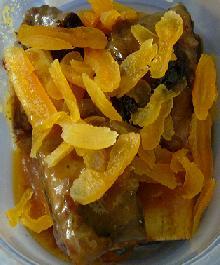
Okay, braising is technically 'out of season', but don't you still love it?
I ordered braised veal cheeks at Vidalia last week and they were wonderful! Does this mean that I am wrong? I don't believe so. There are several ways to enjoy a great braised dish and just 'mixing up' the traditional braising ingredients (mirepoix, herbs, liquid) can make any braising dish summer appropriate.
But first, lets make braising clear. When I meet with new clients - and chat with them about the cooking methods they would like me to employ in their dishes, as I go through a list...saute...broil..roast...braise...most people stop me and say "Whats the difference between braising and roasting? I think I like/hate them both?".
- Roasting: cooking food by surrounding it with dry, heated air. Roasting and baking are esstentially the same, but roasting usually referrs to meats and baking is usually applied to well, baking things, like cookies. Roasting takes place in an oven, be it convection or whatever and the food is literally 'dried out' in the cooking process.
- Braising: In a way, it is roasting a meat, but placing the item in a large, sided pot and covering the roasting item with (up to) a 1/3 of liquid. It is a combination of 'drying out' the food with roasting/baking and 'moistening' the food with a liquid. Braising can be done stovetop or in the oven.
- Stewing: Involves the braising technique, but mostly smaller meat pieces, be them tough (beef chuck) or tender (beef tenderloin), therefore a shorter cooking time. Although the pieces to be stewed may not always be seared or sauteed first, but can also be blanched (veal blanquette). And unlike braising, the meat is covered completely with liquid.
- Poeleing: Involves the braising technique, but usually refers to cuts of meat that are tender and not to fatty (tenderloins, duck breasts) not the usually braised items (short ribs, veal cheeks). The cooking process is a much quicker one, since these items are so tender, therefore limiting the amount of braising liquid and most likely using a 'true' cooks fat (bacon grease, duck fat, butter).
Orange Ginger Beef Short Ribs with Apricots
- 2 T. Butter
- Mirepoix (with about 50% carrots)
- B.G.
- 2 T. Butter
- 1 c. Seasoned Flour
- 4 Beef Short Ribs, extra fat trimmed
- 4 c. OJ
- 1 - 3-4 inch knob of ginger, peeled and diced
- 4 c. Veal Stock
- Muscat or other very sweet white wine
- Butter
- Apricots (1/4 c. julienned dried apricots/person or 1/2 fresh apricot poached in 3:1 simple syrup)
- In a pot large enough to hold the short ribs and cover them completely with liquid, saute mirepoix in butter until golden brown and remove.
- Dust short ribs in flour and saute, getting the outside as brown as possible without burning.
- Add mirepoix, B.G., OJ, bring to boil, simmer, cover pot with foil and reduce OJ by half. *Short ribs should be covered mostly with liquid. (20 min)
- Add knobs of ginger and 1/2 of beef stock, cover and continue to simmer. (30 minutes)
- Add remaining beef stock, cover and continue to simmer, until short ribs are tender and can easily be flaked away from bone. (up to 40 minutes)
- Remove short ribs and set aside. Run braising liquid through sieve to remove B.G., ginger, mirepoix. Then run braising liquid through chinois and return liquid to stove to reduce. You want to reduce the liquid down to sauce consistency (Chefs term) where the syrup is thick, like you would expect sauce to be.
- At the same time julienne dried apricots or poach fresh slices of apricot in simple syrup.
- Once braising liquid is thick, run sauce through chinois with cheesecloth in it. Emulsify (whisk in at low temperature until completely mixed) in 1/2 T. butter/person.
No comments:
Post a Comment